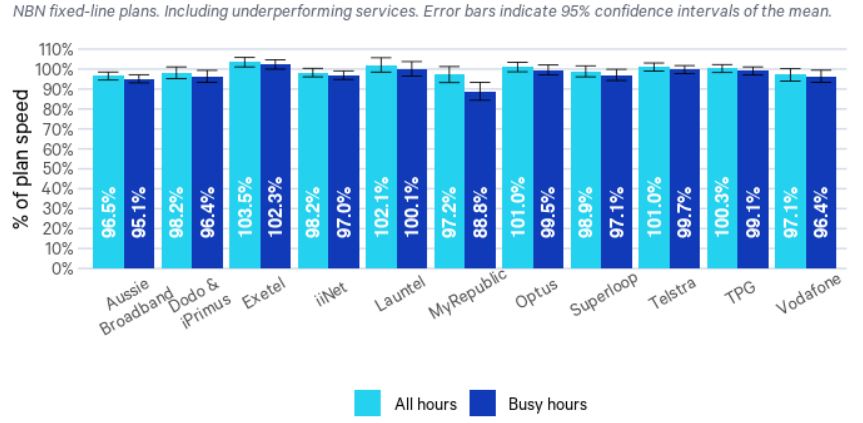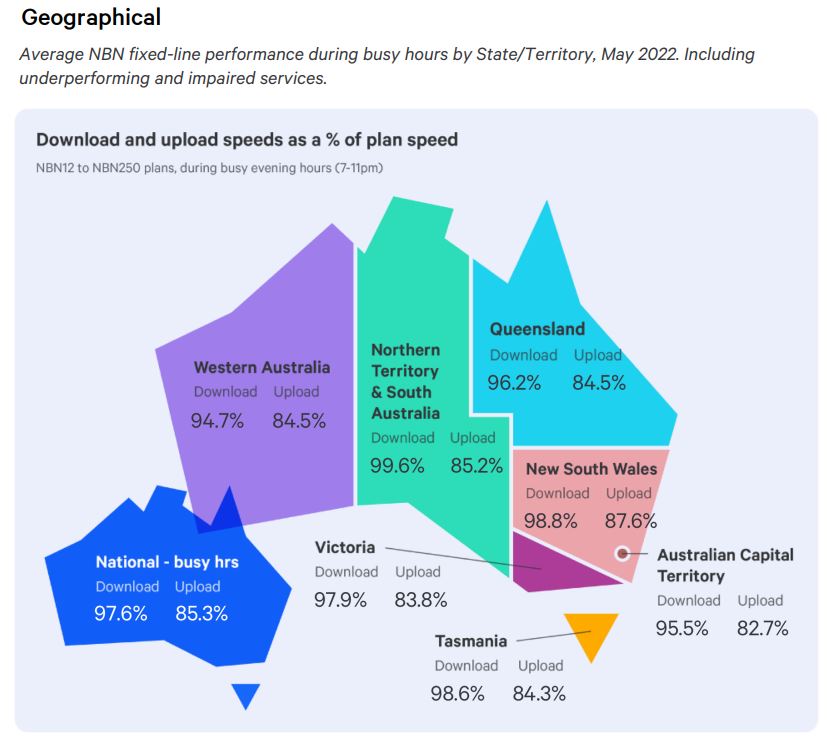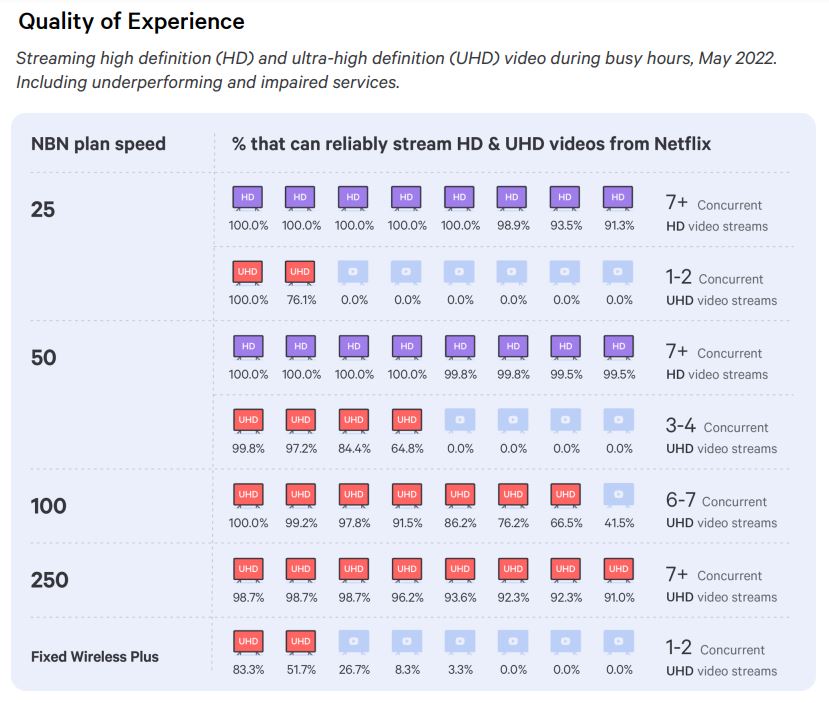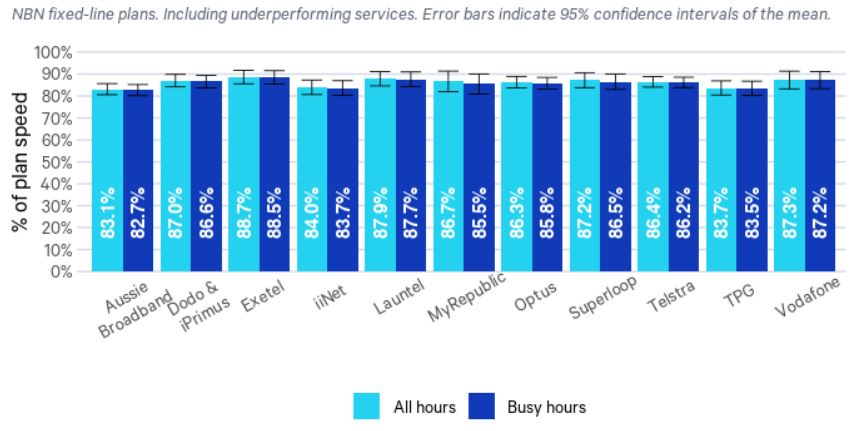Having access to a fast and reliable NBN connection is a must for many Aussie households, which is why the latest Measuring Broadband Australia (MBA) report from the Australian Competition and Consumer Commission (ACCC) brings good news for homes connected to the NBN.
The latest MBA report from the ACCC for the May 2022 quarter, has found that smaller internet provider Exetel, has once again beaten the big telcos to take out the number one spot for NBN speeds, an achievement the telco has managed for three consecutive reports.
The 18th report released by the ACCC shows the results of tests performed on NBN connections serviced by 12 of the most popular NBN providers — Telstra, Optus, Vodafone, TPG, iiNet, Dodo and iPrimus, Aussie Broadband, Exetel, Superloop, My Republic and Launtel. This report looks into the speed performance across all hours, in addition to how these providers perform in the busy evening peak times.
Smaller telcos outperforming the bigger providers, but download speeds are still fast across the board
Compared to the last MBA report (which included figures taken from testing in February 2022), the speeds recorded in the latest period of testing in May 2022 showed a slight increase of download speeds for households with fixed-line NBN connections. The overall average download speed across all providers and during the busy evening peak period (7pm-11pm) was up to 97.6% compared to the 96.5% overall average speeds recorded in February.
The best-performing of the 12 providers tested was Exetel with its third consecutive number one ranking with an average download speed of 102.3% of the maximum attainable speed during the peak evening busy period. This report also saw Launtel jumping up into second place as the only other provider to achieve a result over 100%.
The full download speed results are:
- Exetel: 102.3%
- Launtel: 100.1%
- Telstra: 99.7%
- Optus: 99.5%
- TPG: 99.1%
- Superloop: 97.1%
- iiNet: 97.0%
- Dodo & iPrimus: 96.4%
- Vodafone: 96.4%
- Aussie Broadband: 95.1%
- MyRepublic: 88.8%
There’s been a reasonable shift since the last report with some telcos gaining and others dropping, despite an overall faster result than the previous report. Despite Launtel only being included in the last couple of reports, the telco has jumped up into second spot with 100.1%. Telstra moved up a spot into third and increased its speed from the previous report up to 99.7%. Optus dropped from its previous second position into fourth for this report, reaching 99.5%, while TPG was steady in fifth place with 99.1%.
During the testing period, 433,353 download speed tests were taken on 1,209 Whiteboxes connected to a fixed-line NBN connection. There was a general improvement of speeds on this report compared to the previous report with 68.6% achieving at least 100% of plan speed during these tests (up from 65.6% in the previous report).

Compare NBN plans
If you’re looking to compare how the above mentioned NBN providers stack up when it comes to plan cost, the following table shows a selection of published unlimited NBN 50 plans from Canstar Blue’s database, listed in order of standard monthly cost, from the lowest to highest and then by data allowance, largest to smallest. Use our NBN comparison tool to see plans from a range of other providers. This is a selection of products with links to a referral partner.
Ultrafast NBN 1000 speed performance
The ACCC includes numbers on how the NBN’s ‘Ultrafast’ speed plans (NBN 1000) are performing, as more Aussie households have access and connect to these faster speed plans. During the reporting period, 41,656 download speed tests were performed across 121 Whiteboxes connected to fixed-line NBN connections. 45.5% of these tests achieved a download speed of at least 900Mbps.
The hourly average download speeds achieved on these ultrafast services ranged between 659Mbps and 820Mbps, with the performance varying the most during the peak evening busy period (7pm-11pm).
Fastest NBN speeds by state
The ACCC has also broken down how NBN speeds perform on a state-by-state basis for both download and upload speeds.
The best performing region in Australia for download speeds was the Northern Territory/South Australia with 99.6% of the maximum speed available, followed by New South Wales with 98.8% and then Tasmania with 98.6%, while Western Australia performed the worst with 94.7%. New South Wales was the best performing state for upload speeds with 87.6%, followed by the Northern Territory/South Australia with 85.2%.

Best NBN speeds for reliable Netflix streaming
In addition to testing speeds and providers, the ACCC also runs tests on how reliable the NBN is when it comes to streaming Netflix in high definition (HD) and ultra-high definition (UHD). These tests are taken on fixed-line NBN connections across NBN 25, NBN 50, NBN 100 and NBN 250 speed tiers, along with fixed-wireless NBN connections.
The testing taken in May saw that NBN 50 was able to run one UHD stream in 99.8% of tests, however it was able to run up to four HD streams in 100% of tests. NBN 100 was able to run one UHD stream in 100% of tests, while going up to two UHD streams was achieved in 99.2% of tests. NBN 250 however was only able to achieve one, two and three UHD streams in 98.7% of tests — down from the three UHD streams in 100% of tests included in the last report.

NBN upload speeds still underperforming, says ACCC
While download speeds are generally performing better now than they have in previous years, upload speeds are still lagging behind, mostly due to NBN Co not overprovisioning on upload speeds, like it does for download speeds. The ACCC has noted that there has been no significant improvements for upload speeds since early 2020.
“Upload speeds are more substantially below maximum plan speeds because NBN Co doesn’t overprovision the upload link,” said ACCC Commissioner, Anna Brakey. “Upload speeds are important to consumers working or studying from home, or using cloud applications such as photo storage.”
The May report found that Exetel had also topped the upload speed performance, achieving an average performance of 88.5% of the maximum attainable speed, followed by Launtel with 87.7% and Vodafone with 87.2%.
The full upload speed results are:
- Exetel: 88.5%
- Launtel: 87.7%
- Vodafone: 87.2%
- Dodo & iPrimus: 86.6%
- Superloop: 86.5%
- Telstra: 86.2%
- Optus: 85.8%
- MyRepublic: 85.5%
- iiNet: 83.7%
- TPG: 83.5%
- Aussie Broadband: 82.7%

Should I switch NBN provider?
As the ACCC runs these tests every few months, the results will typically change with the reports every quarter. Some providers who have topped these reports in the past, have seen performance drop in more recent reports, and it’s likely this will continue to change in the future.
While it’s a good idea to keep an eye on these reports to see if your provider is offering a consistent speed result — or if there is an NBN provider offering a better average performance compared to your current plan — this shouldn’t be the determining factor as to whether you switch NBN plans or stay put.
Considering the current rise in the cost of living and many Aussie households looking to cut costs, you might prefer to look into comparing cheap NBN plans to see what’s out there. There are plenty of smaller providers that are not included in these ACCC tests, so you could still find great value with another provider. Overall, it’s useful to know how the popular NBN providers compare when it comes to performance, but it shouldn’t be your deciding factor on choosing an NBN plan.


Share this article